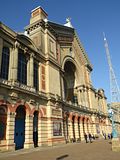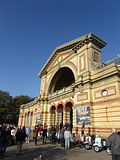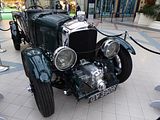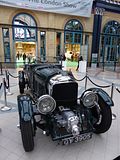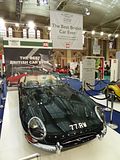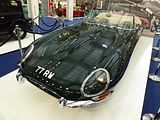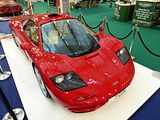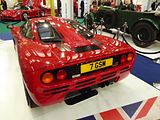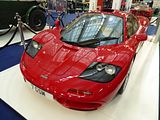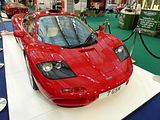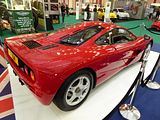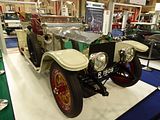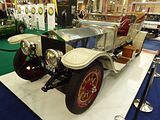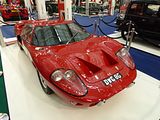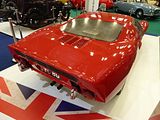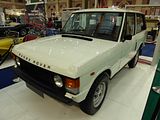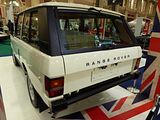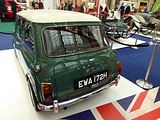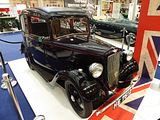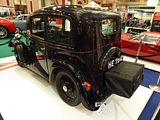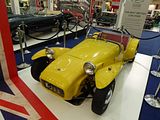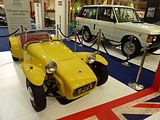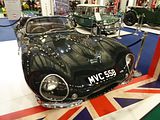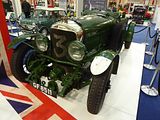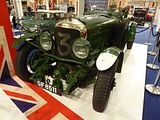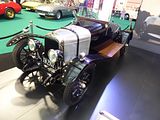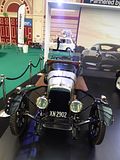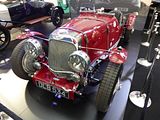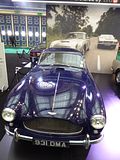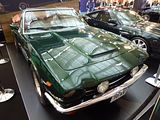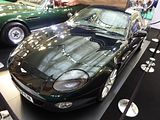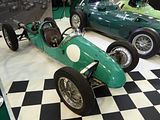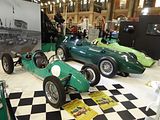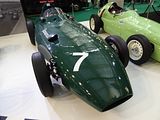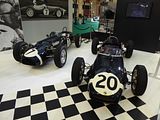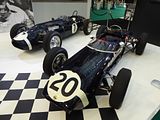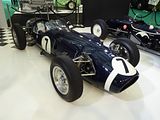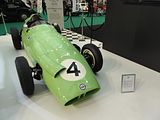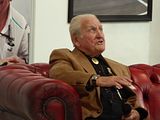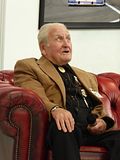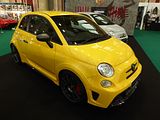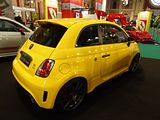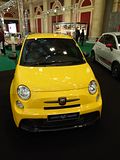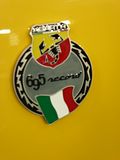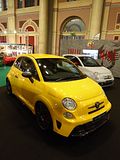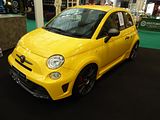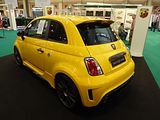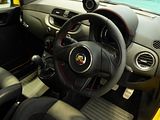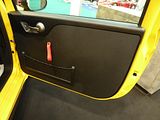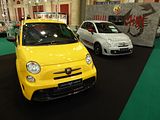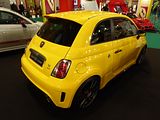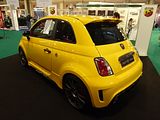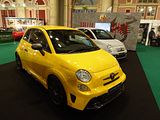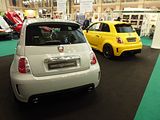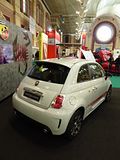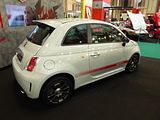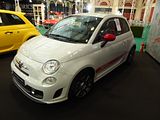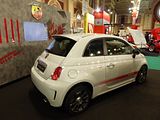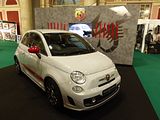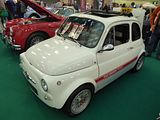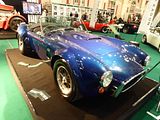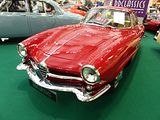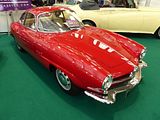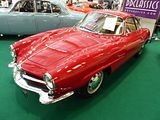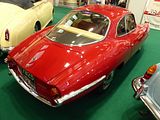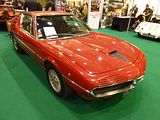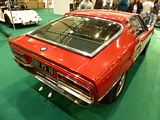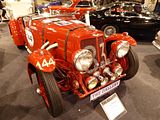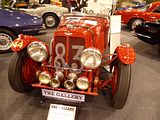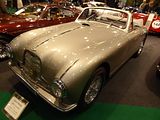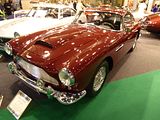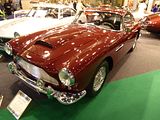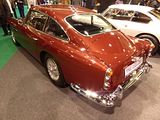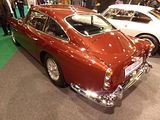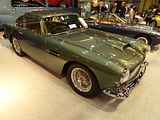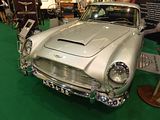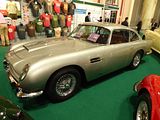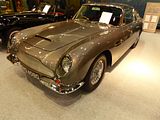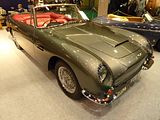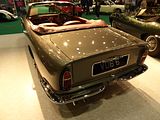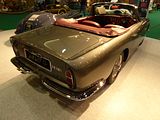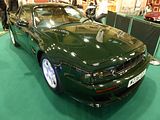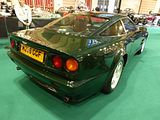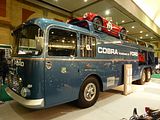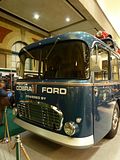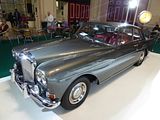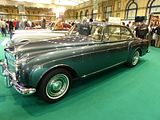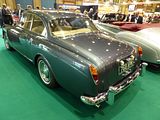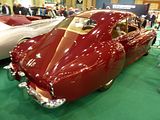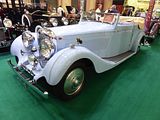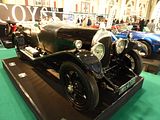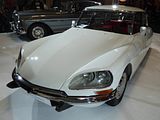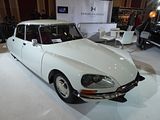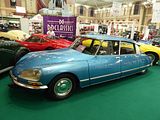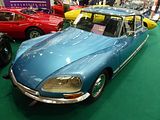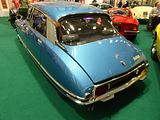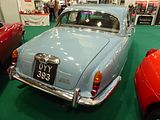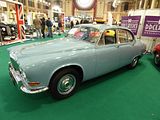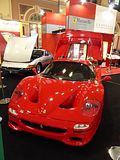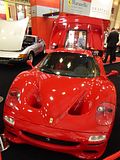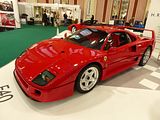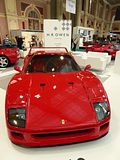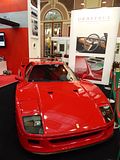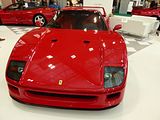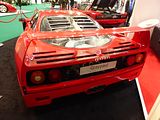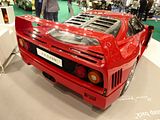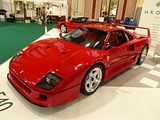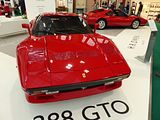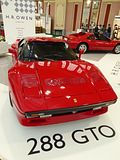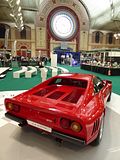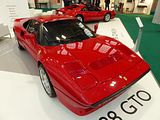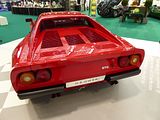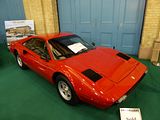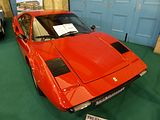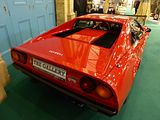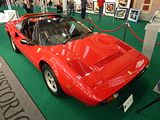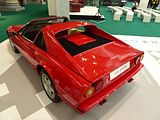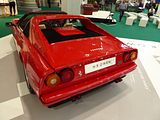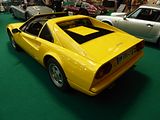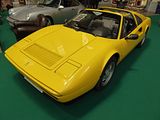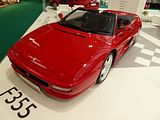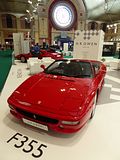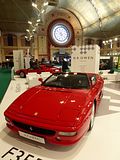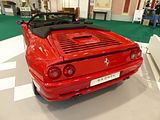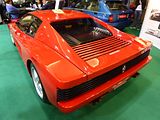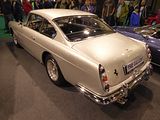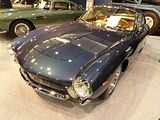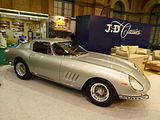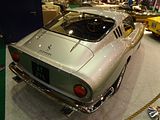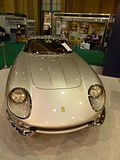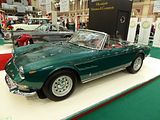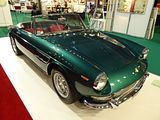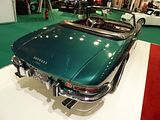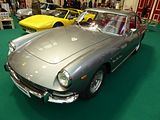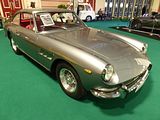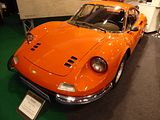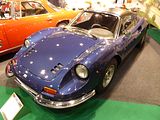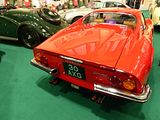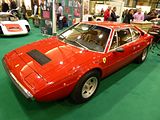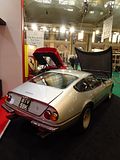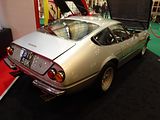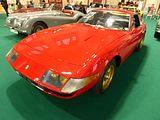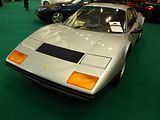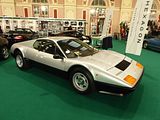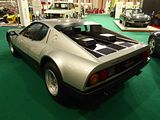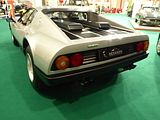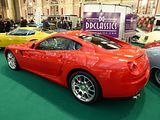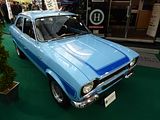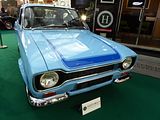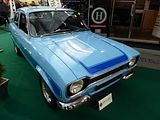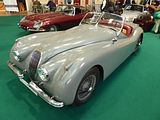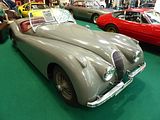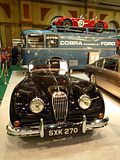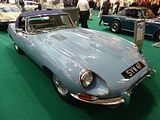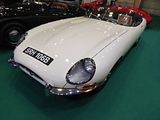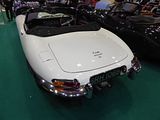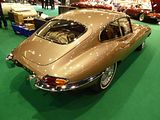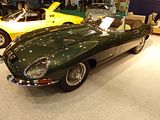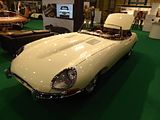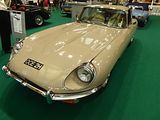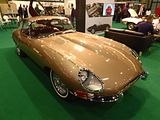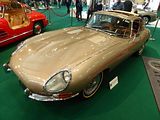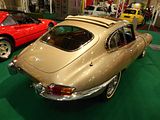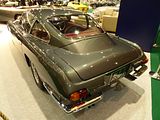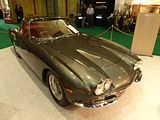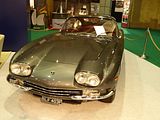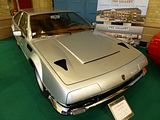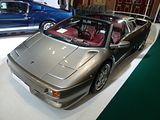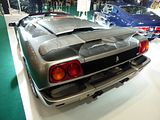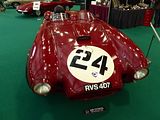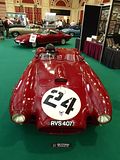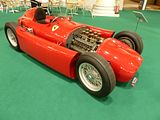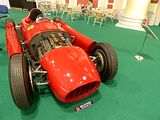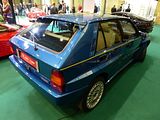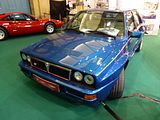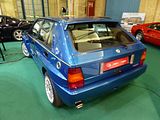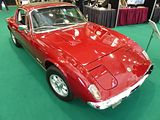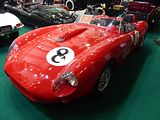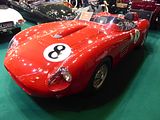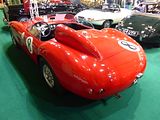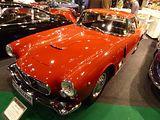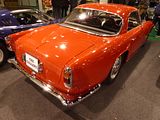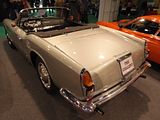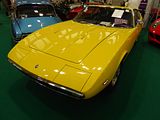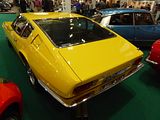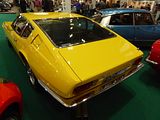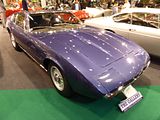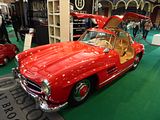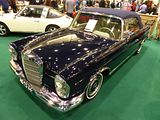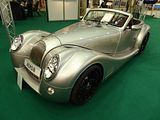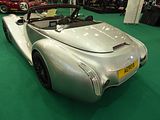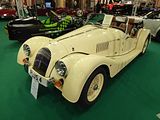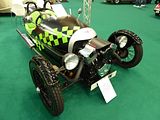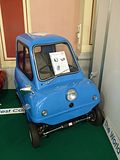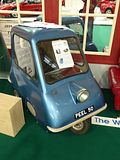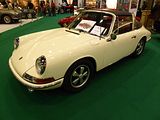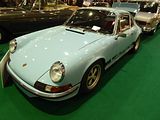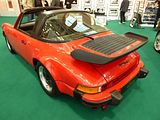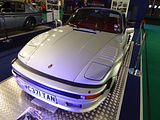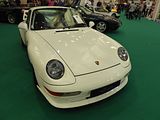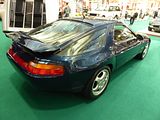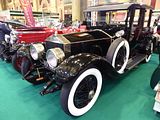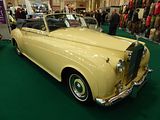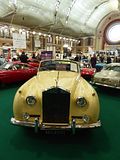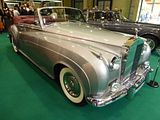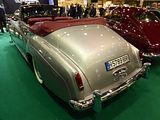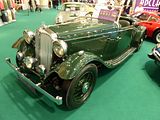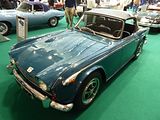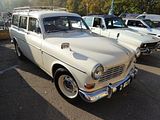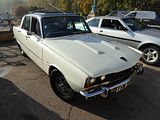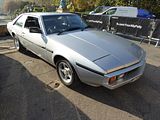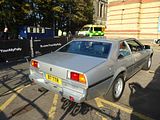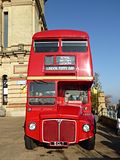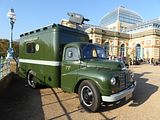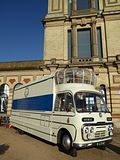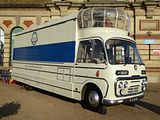The last time I came to a classic car event at London’s Alexandra Palace was in 2008, when the historic venue was still hosting the annual London Classic Car Show. 2008 proved to be the last of the line, though, with the event pulled from the schedules from 2009, with reasons being cited, among others, that as exhibitors would have to come inside the Low Emissions Zone that had recently been imposed, this would be too strong a disincentive for those who rely on non-compliant lorries and transporters to get their content to such a venue. Whether this was the real reason or not has never really emerged, but the reality is that there were no more of these events, or indeed any other in the London area. Until 2015, that is, when two new events were added to the calendar. The first, which took place in January, was held out east at the ExCel Exhibition Centre, and was well received with the novelty of an area in the middle of the venue where cars could be driven up and down. Finding something different but equally compelling for the second event, to be held at the Alexandra Palace at the end of October, must have challenged the imagination of the organisers. Masterminds of the event were the staff at the world’s largest selling and authoritative classic car magazine “Classic and Sports Car”, and they clearly set about their task with plenty of enthusiasm and vigour. It all worked, though, as more than 15,000 people packed into the show halls at Alexandra Palace over the 3 days of the event, hoping to see some of the world’s finest classic cars at the inaugural Classic & Sports Car – The London Show. They were not disappointed, as more than 300 stunning cars filled the event halls for the three-day show, with three special displays, an array of well-known names on stage for Q & A sessions, and a program of activities outdoor. I attended on the last day. It started out shrouded in mist, but eventually, the sun burnt through it, to create a clear and bright autumn day. That was enough to encourage the crowds, and for a while, the halls were really rather busy, certainly too busy for the photographer, though by mid afternoon, the venue started to empty, and I could get pictures of the cars which had eluded me earlier in the day.
The first car that I saw was this Blower Bentley, located in the Palm Court, the main atrium area of the Palace, and what could be more quintessentially British than this?
SPECIAL DISPLAYS
AUTOGLYM BEST BRITISH CAR EVER
At the heart of the event, right in the middle of the main exhibition hall was a special display, sponsored by AutoGlym, but masterminded by the event’s organisers, which was the culmination of a 6 month process to find the “Best British Car Ever”. It took 6 months to reach a conclusion, with a panel of 100 celebrities and motoring experts including McLaren F1 designer Gordon Murray and Pink Floyd drummer Nick Mason, contributing to a shortlist of 10 models. These were then put to a far wider poll, and Classic and Sports Car readers and other enthusiasts voted on this in their thousands. All 10 cars from the shortlist were on show at the event, resulting in a display stand with content worth in excess of £40 million. In the end, the accolade of “Best British Car Ever” went to the Jaguar E-type, and a very special example was on show. The display car as 77RW, one of the launch cars, the very car Norman Dewis (more on him later in the report) drove over to the Geneva Show in 1961 when demand for test rides in the initial Coupe model that had been sent over there was so overwhelming that a second car was called for.
I confess that I did register my own vote, but if I had, I could easily have been tempted by the McLaren F1. You don’t see these cars very often, which is perhaps not a surprise given how few of them there are and how valuable they are. This red one is a car I first saw at Wilton House in 2014, and I decided that it looks particularly good in this colour.
Included in its own right, as one of the ten finalists was the Rolls Royce Silver Ghost, but there was an extra poignancy to its inclusion here, as this Roi des Belges model was a particular favourite of the late Lord Montagu of Beaulieu who passed away on 31st August this year, so including this car was a fitting tribute to the man who did so much to create the interest in old cars that has become such an absorbing hobby and massive business that so many of us enjoy today.
Also very splendid was this stunning Ford GT40, on loan from Ford’s historic vehicle collection.
Other cars in the running for the title were a Range Rover, a Mini Cooper, an Austin Seven, Lotus Seven and the Jaguar XKSS.
Final car in this section was a 1930s Bentley, the car that Ettore Bugatti memorably called “the fastest lorries in the world”. The particular car seen here, which I had last seen a few weeks previously at Salon Privé. has lots of history, as it is the car known as “Old Number Three”, a Speed Six. Factory-raced Speed Six Bentleys contributed more to the Bentley story of the late 1920s and early 1930s than did any other model. These specially prepared models won the 24 Hours of Le Mans as well as the famed Brooklands Double Twelve. Three of the factory works cars, known as Old Number 1, 2 and this one, Number 3, dating from 1930, garnered most of the acclaim and are currently considered the most desirable of all Bentley models. Bentley’s association with Le Mans goes back to 1923 and the inaugural race in which a 3 litre model finished fifth, with tentative factory support. Victories followed in 1924 and 1927, still with 3 litre cars, then in 1928 when Barnato and Rubin triumphed in a 4.5 litre and again with Barnato and Birkin in a Speed Six in 1929. For 1930, WO Bentley wanted to notch things up a level, so with the sole intention of dominating at the Brooklands Double Twelve and Le Mans, another pair of Speed Sixes were built. they had 11 foot wheelbases and, as was required by the French rules, were fitted with four seater Vanden Plas bodywork. They were readied for competition by detuning the brakes for longevity, were given extra shock absorbers and were fettled to generate 200 bhp. This car, Old Number 3 – made its debut at the Double Twelve in May 1930, where it came second to its sister car in the hands of Sammy (SCH) Davis and Clive Dunfee. The same pairing took the car to Le Mans the following month. Davis started the race, trying manfully to stay with the Mercedes SS of Caracciola, a task made more difficult when a stone smashed through his goggles, not just ruining visibility but giving him agonising splinters in his eye. He stayed out the planned 210 laps before handing over to Dunfee, who then almost immediately planted the car in the bank at Pontlieue. It took a while to dig the car out, and when they did manage it, it was clear that the front axle was twisted beyond repair and the car;s race was over. The other two Bentleys came in first and second though, with Barnato on the top of the podium. This proved to be Bentley’s last hurrah at the event, not returning until 2001. It was not the end for Old Number 3, though, which with the addition of full weather gear was driven by Sir Henry “Tim” Birkin in the 1931 Double Twelve, where the car lead early, but then retired needing an engine rebuild. After that, the car was sold to HJ Thomas of the Bristol Aeroplane Company in October 1932 for £750. Thomas modified it to be a road car, and sold it to a Philip Crowther the following year for the sum of £750 and his Hispano Suiza Monza. The car had many owners after that, and received an engine swap before David Vine reunited car and engine in the 80s and returned it to le Mans guise. He sold it in 1995 and in 2000 the car was bought from Switzerland by collector Peter Neumarkt, and it has remained in his family ever since. It’s had plenty of use in the last 15 years, including rallies and endurance trials. In 2009 it was shipped to the US, the Bentley year at Pebble beach, where the car came third.
HISTORY OF ASTON MARTIN
Another of the main features of the event was a celebration of Aston Martin models through the ages. The marque celebrated its centenary a couple of years ago, so there was no particular anniversary being marked here., but rather the fact that this very British firm is much loved by enthusiasts in the UK and beyond, and so a display of some of the notable models from the firm’s history seemed like a great complement to the Best British car display.
Highlight for many would be a chance to see A3, the oldest Aston Martin in existence. Bamford and Martin Ltd was incorporated in 1913 to formalise a partnership between Lionel Martin and Robert Bamford. They had been modifying and selling Singer cars from their workshops at 16 Henniker Place, Callow St, Kensington, London. A decision was made to start and build a whole car of their own design and by 1915, the first Aston-Martin, named Coal Scuttle hit the road. More cars weren’t built until 1920 but that was due to the Great War getting in the middle of things. Following Coal Scuttle, three more prototype cars were built including Bunny (no longer in existence) and this one, chassis number A3 which was the third Aston Martin ever built. Its black paint led to it having a pet name that would not be considered suitable in this day and age. All of the Works Cars of Bamford and Martin had pet names, something started by Lionel Martin’s wife, Kate. This tradition continues to this day as many if not most have pet names for their cars. Despite being modified again and again, A3 somehow survived. Only when it was put up for sale at auction in 2001, was it discovered that this car carried chassis number A3 which made it the third Aston Martin ever built and the oldest in existence. Despite having been modified again and again it somehow, against all the odds survived. Now owned by the Aston Martin Heritage Trust (AMHT), this car has been seen in public quite a lot since the Aston centenary in 2013, and following an extensive renovation after the car’s (re)discovery and full rebuild which started in 2006, to bring the car back to its 1921 specification by Ecurie Bertelli. This has included the black paint which lead to it having a pet name that would not be considered suitable in this day and age. All of the Works Cars of Bamford and Martin had pet names, something started by Lionel Martin’s wife, Kate. This tradition continues to this day as many owners still give their Aston Martins a pet name. A3 is not a particularly, powerful car with only a 1.5 litre 11 hp four cylinder side valve engine but in 1923 was able to lap Brooklands at 84.5 mph.
The second oldest Aston Martin here was also rather special. It is a 2 litre Speed, dating from 1936. Just 23 of these cars were made, to homologate the car for Le Mans, though sadly having achieved this, the race was then cancelled. It was later entered, along with competing in the Mille Miglia. The car seen here was given an Ulster style body in the 1970s.
The rest of the collection showed representative examples of the marque in chronological order being the mid 1950s DB Mark III, a DB5 from the 1960s, a V8 Volante from the 1970s and 80s, a DB7 and the very latest Vanquish.
SIR STIRLING MOSS FEATURE
At the other end of the main Hall was a display of some of the most significant single-seaters raced by Sir Stirling Moss. Oldest car in the display was the Cooper Mark IV Formula 3 car in which he dominated the 1950 season. This car followed from the Mark II Cooper which a young Moss had persuaded his father to buy. That had been replaced by a Mark III, before the arrival of the Mark IV, with its JAP engine, which Moss entered in 23 races. He sold the car to Charlie Graham in 1951, who then put his own body on the car. Sir Stirling was reunited with the car at the Chateau Impney event in July 2015.
By the mid 1950s, Moss was driving a Vanwall, this VW5 that is usually to be seen in the Donington Collection. He became the first Briton to win his home Grand Prix and in 1956 he won the inaugural Constructors Championship for the team. But Vanwall had only a brief existence and by 1961, the team had gone.
The BRM P25 is the car that Moss drove in the 1959 French Grand Prix, a car that he famously tried in vain to push-start having spun at Thillois. This is the first car in which a 100 mph lap was completed at Silverstone, and Moss competed in the car against Tony Brooks in the Ferrari, but the sad reality is that the car was not competitive enough and he stood no chance in winning the Championship.
Hence a move to Lotus for 1960. This Rob Walker-liveried Lotus 18 is the car with which he famously did the double of the 1960 and 1961 Monaco Grand Prix. In 1960, the car was a factory entry and Moss’ victory at Monaco was the first for the Norfolk team, but by 1961, the Lotus team were more interested in the new Lotus 21. Moss stuck with the older Type 18, and brought the car with a victory of more than 3.5 seconds over the factory car.
Also on show was the technical tour de force of the four wheel drive Ferguson P99. The first and only four wheel drive Formula One car, it remains the only Ferguson Grand Prix car, and when new was driven by Tony Rolt, winner of the 1953 le Mans race.The car had a second career, in hill-climbing, and Moss drove it in 1964 in this form of the sport.
THE STAGE SHOW
Celebrity guests from the world of motoring were also out in force, led by “For The Love of Cars” and “Building Cars Live”’s Ant Anstead. The TV presenter and owner of The Evanta Motor Company was given the honour of opening the event on Friday morning, as well as unveiling the winning Jaguar E-type and taking part in an informal chat with Henry Hope-Frost on the event’s Smooth Radio Interview Stage. During the three days of the event, a series of personalities from all works of motoring life were timetabled to appear on stage for an interview with Henry Hope-Frost and the chance to take questions from the audience. Unlike some events, where the same people appear many times, everyone here got one shot, so if you missed them, that was it. On the two days prior to my attendance, interviewees had included Le Mans winner David Brabham, rally BMC and Ford legend Stuart Turner, Formula One engineer and former team boss Ross Brawn, the designer of the McLaren F1, Peter Stevens, former racer Mike Wilds, Paul Michaels of Hexagon, Tom and Henry Mann, the sons of racing team legend Alan, as well as Sir John Egan, the man who rescued Jaguar from an almost certain demise after BL had starved the firm of everything. Chris Goffey talked about what life was like on Top Gear long before the program’s cult status, and Paddy Hopkirk apparently had the crowd in stitches with his witty banter.
The first person whom I listened to was Jaguar’s greatest test driver Norman Dewis, now a spritely 95 years old. He has said that he plans to drive a car, and not just any car, but the unique Jaguar XJ13 prototype, at 100 mph on his 100th birthday, and I have every confidence that he will be around and fully capable of doing so. also made an appearance on the Smooth Radio stage, enthralling the crowd with stories from his world of motoring. He started by explaining how he was persuaded to join Jaguar from Lea Francis, where he had been happily employed as their Chief Tester, and then had numerous stories and perspectives on what it was like to develop the world famous C and D Type Jaguars, his epic 17-hour dash from Coventry and across Switzerland in the very Jaguar that represented the model in the Autoglym Best British Car Ever poll – ‘77RW’, the frustrations of the British Leyland era, and how we got around the embargo of driving the XJ13, as well as the tale of the very high speed crash when he was driving the car some years later for a promotional film. With more than a twinkle in his eye, he talked about a Speed Awareness Course that he attended, having been caught speeding (something that happened rather a lot in the same year, recently!) which was at Silverstone. Whilst waiting for it to start, he was admiring a series of historic photos on the wall, and the instructor saw him so doing, but clearly did not recognise him. The last photo was of the XJ13, so somewhat playfully, Norman asked the guy of he knew what it was, He was told it was an XJ13, and that sadly it had been involved in a very nasty crash, but the guy went on to say that he thought that the driver had survived. Norman said he looked at him, and confirmed that this was indeed the case, as he was indeed that driver. He still had to do the Speed Awareness Course, though! He was on stage for nearly an hour, three times the allotted time, and he could easily have gone on for a lot longer. An incredible gentleman. It was worth the admission fee just to listen to him.
Second person that I listened to was Simon Taylor, well-known journalist and broadcaster, who explained how he became the editor of Autosport magazine following the acquisition of the title by a publishing empire owned by one Michael Hesseltine, how he took a chance in his first ever BBC commentary at the Japanese Grand Prix in 1976 when the difference between his own lap charts and the official ones was the difference between James Hunt winning the title or not. Simon stuck with his instinct, and luckily was proved to be right. He then outlined how “Classic and Sports Car” was founded back in 1982, the result of his company, Haymarket Publishing, having acquired an almost moribund title “Old Motor” and then deciding to cover the topic “properly”. A fascinating chap to listen to, with all sorts of tales from his time at Pebble Beach, when his fabulous Bentley Sedanca de Ville won an award, to his exploits behind the wheel of the Stovebolt Special at hill climbs around the country.
OTHER DISPLAYS
Classic Car specialists from across Europe pulled out all the stops, with a number of displays that filled the rest of the exhibition halls. Most of them had open access to their stands – not something that they always offer – which allowed everyone the chance to get up close to some very desirable metal indeed. Many well known names were here, with Silverstone Auctions, HR Owen, Graypaul and Classic Motor Cars of Bridgnorth joined by the likes of Gallery Brummen from the Netherlands, Desmond J Smail, DD Classics and JD Classics. Many of them reported brisk trade and some big sales, so you can be sure that they would willingly return to this event in future years.
ABARTH
One of only two manufacturers showing new cars was Abarth, and they made sure that they had something special on display. The yellow car is a 695 Biposto Record edition, a model which was first seen at the Paris Show a few weeks earlier. Celebrating the 50th anniversary of Carlo Abarth’s astonishing legacy of 133 international records, just 133 of these cars will be made, all finished in Modena Yellow. As such, it could be a while before getting a chance to see another one. Mechanically the same as the production 695 Biposto, I noticed that you do get air conditioning in this car, and the door panels are different, but there is still no radio and there are only two seats. I concluded that whilst a lot of fun, a Biposto is a little to raw as a road car, but the sight of this yellow one did cause me to wonder again……… then again, £36,610, which is what it costs is an awful lot more than I paid for my 180 bhp Competizione model.
Alongside was a “regular” 595 Custom. This is the new name for the entry level Abarth model, sporting the 140 bhp T-jet engine. Priced at a little over £14,000, there is no doubt that this is a bargain, and as I found it, will not just give the owner a lot of fund, but the residuals are particularly strong when you come to sell it.
Elsewhere there was a classic 595 offered for sale. This is not an original car, but a modern recreation, taking a standard Nuova 500 as the base. Originals are extremely rare and costly, but something like this would be an affordable way into having just as much fun.
AC
Cobra 427
ALFA ROMEO
There were only a couple of Alfa Romeo models in the show. Older of the two cars to be seen was this 1963 Giulia 1600 SS. These are rare cars, with just 1,366 examples being made between 1957 and 1965. The first cars were fitted with the 1,290cc Giulietta engine and then in 1963 with the more powerful 1,570cc Giulia unit. The SS, or Sprint Speciale series was never intended to be a volume car and it was considerably more expensive than the other models in the Giulietta and Giulia ranges. It certainly looked special, with streamlined bodywork which bore a marked resemblance to some of the marque’s earlier competition designs, particularly the famous Disco Volante sports-racer, not to mention the BAT 9 show car. With an all-up weight of under 950kgs, a five-speed gearbox and an output of ll2bhp (in Giulia form) these were excellent road cars and were equally used in competition. They don’t come up for sale very often, and needless to say, the price tag is not small when they do.
The other Alfa on show, also for sale, was an example of the Montreal. First seen in 1967 as a concept car for Expo67, the car took its name from the Canadian city where the event was held. Reaction was so positive, that Alfa decided to put the car into production, though it took a further three years to get the car ready for commercial sale. This V8 Coupe was then offered for five or so years, and proved quite difficult to sell. Until recently, that was still the case, as it was a complex car with a reputation for being very difficult to get it to run perfectly. In the last couple of years, though, its true merits have been recognised, there are far fewer for sale at any given time, and prices have risen accordingly.
ASTON MARTIN
This 1939 15/98 2 litre was on The Gallery, a Dutch dealer’s stand, and was described as a 1 off
This 1951 DB2 Convertible is an example of the first new post war design produced by Aston Martin, and was the first car to use the DB name, reflecting the fact that in 1947 David Brown had bought the Aston Martin and Lagonda companies and incorporated them as Aston Martin Lagonda Ltd. Lagonda’s 2.6 litre dual overhead cam, straight-six engine, more powerful than the pushrod 1.9 litre unit in the Aston Martin 2-Litre Sports, was the main objective in Brown’s acquisition of the company. W. O. Bentley had supervised the engine’s design, which was largely by William (Willie) Watson, an engineer with the pre-war Invicta company who had collaborated on Lagonda’s pre-war V12 and also designed the short-lived post-war version. Work then started on producing a new car, which was called the DB2. This new model would utilise a version of the Lagonda engine in a shortened version of the tube-frame chassis designed by Claude Hill for the Aston Martin 2-Litre Sports, with a fastback coupé body designed by Frank Feeley. Three pre-production cars were entered for the 1949 24 Hours of Le Mans. One, which would become the development car for the production DB2, had the Lagonda straight-6, while the four-cylinder Aston Martin 2-litre unit powered the other two. After six laps the Lagonda-powered car, driven by Leslie Johnson, retired with overheating caused by failure of the water pump. One of the 2-litre cars was in 4th place and running without brakes when it crashed two hours short of the finish, fatally injuring driver Pierre Maréchal. The other finished 7th, crewed by Arthur Jones and Nick Haines. A month later, the larger-engined car, driven by Leslie Johnson and Charles Brackenbury, finished 3rd in the Spa 24-hour race, where one of the 2-litre cars was driven to 5th by Nick Haines and Lance Macklin. For 1950 all three factory team cars were equipped with the Lagonda engine. At the 1950 Le Mans race the one driven by George Abecassis and Lance Macklin finished 5th, with Brackenbury and Reg Parnell bringing another home 6th, which won Aston Martin 1st and 2nd in the 3-litre class. Across the Atlantic, Briggs Cunningham drove his DB2 to 2nd in its class at the inaugural Sebring race meeting in December 1950. The factory team cars continued racing in Europe throughout 1951, including at Le Mans, where Macklin and Eric Thompson took 3rd overall, with Abecassis and Brian Shawe-Taylor 5th. David Brown soon embarked on a series of Aston Martins designed specifically for competition use, starting with the DB3. Meanwhile, the production DB2 debuted at the New York Auto Show in April 1950 and continued in production until April 1953, by which time 411 had been made. The first 49 had a chrome-framed front grille in three separate parts, and large rectangular cooling vents in the front wings. Subsequent cars had a one-piece grille with horizontal chrome slats, and no side vents. The single-piece bonnet was hinged at the front. At the rear of the fixed-head coupé (FHC) a small top-hinged lid gave access to the spare wheel, and luggage space was behind the front seats, accessible only from inside the car. Later in 1950, a Drophead Coupé (DHC) variant was introduced. At least 102 were built. In April 1950, an engine with larger carburettors, inlet camshaft the same as the exhaust (for increased duration), and higher compression ratio pistons (8.16:1) was made available. Aston Martin’s first Vantage upgrade option offered 125 hp. Initially the higher compression ratio made the engine unsuitable for the British market, as the postwar austerity measures of the early 1950s restricted UK vehicles to 72 octane “Pool petrol”. The first DB2 Vantage, LML 50/21, was delivered to, and raced by, Briggs Cunningham in the United States. A revised version of the DB2 was launched in 1953, called the DB2/4. It was available as a 2+2 hatchback, marketed as a Saloon, as a Drophead Coupé (DHC) and as a 2-seat Fixed Head Coupe. A small number of Bertone bodied spiders were commissioned by private buyers. A further update in 1957 created the Mark III, and this was produced until the launch of the DB4 in 1958.
There were several of the DB4, DB5 and DB6 models on show here. This stunning looking car continues to go up and up in value and it is not hard to see why. The association with the James Bond franchise no doubt helped and is one reason why the DB5s remain the most valuable of the lot, though prices of the others are rising steadily and you would not have been able to secure this glorious 1967 DB6 Volante, 1 of just 29 made, for anything less than hundreds of thousands of pounds.
There was also an example of the hairy-chested Vantage V600 here. This car is full of extremes; a genuine top speed of 200 mph, a weight of almost 2000 kg, power output peaking at 600 bhp @ 6500 rpm and a price tag at launch of a whopping £233,682 with all the mods. But all of this is eclipsed by its full name of Works Prepared Aston Martin Driving Dynamics V600 Vantage or something like that. Strictly speaking, this isn’t a discreet model as such but is a collection of modifications developed and fitted by Works Service for the supercharged Vantage model post registration. As well as an uprated engine, other modifications available for the car were numerous and included ultra lightweight hollow spoke magnesium Dymag wheels, giant brake discs with circumferential cooling grooves plus AP racing callipers, stack digital instruments and reworked suspension with Eibach springs, adjustable Koni’s and a stiffer anti-roll bar. Many cars also have a five speed close ratio manual transmission although it is possible to see V600’s with automatic transmission. Central to the V600 is this, the most powerful Aston Martin road car engine of all time until it was toppled by the One-77. Essentially, this final version of the Tadek Marek V8 features performance engineering of the charge air intake cooling system, increased boost pressure and a big bore sports exhaust, described by AML as ‘Super Sport’. So far as is known, Aston Martin Works have converted in excess of 80 engines to V600 spec including regular V8 Vantage, Special Series Cars, Vantage Le Mans and Special Edition Vantage Volantes. That said, Works have also stated that only 9 standard V8 Vantages were made V600 immediately after first registration. Even now, Works are still able and capable to upgrade any supercharged Vantage to V600 spec, 17 years after the modification was first introduced.
AUSTIN HEALEY
3000
FIAT-BARTOLETTI
Dominating the smaller of the two exhibition halls was this splendid Bartoletti transporter in AC livery, loaded with a Cobra 289 and the Frua-bodied Willment car, which was to be found on the JD Classics stand
BENTLEY
Although the S Series Bentley, along with the sister model Rolls Royce Silver Cloud, were available with standard factory bodies, many customers still chose to have the chassis sent to their favourite coachbuilder, so there are a number of different body designs that you will see on these cars. Two different ones were shown here: a Mulliner Park Ward version of the S3 Coupe and an DropHead Coupe Continental S2 bodied by HJ Mulliner.
This is an older Continental R Type.
Back in the late 1930s, almost all what are now known as the “Derby” Bentleys came with one of a series of coachbuilt bodies. This one dates from 1937 and is a 4.25 litre Hooper Drophead
On the Coys Auction stand was a lovely 3 litre model, dating from 1925 and with a Vanden Plas body. The genre of the sporting Vintage Bentley dates from the earliest days of Walter Owen Bentley’s founding of the firm that bore his name and the partnership of his chassis and coachwork which was provided by local coachbuilder Vanden Plas. Between them they created a style that remained with the company throughout its first era of production: that of a compact sports car with lightweight open four seater touring bodywork. It was in this same guise that virtually all of the famed Le Mans campaigns were undertaken. Even when the 4-cylinder cars were usurped by their 6-cylinder models, the most sporting examples were still built in this guise. The legend of the ‘Bentley Boys’, Tim Birkin and their Le Mans successes, created the spirit and character of the brand that perpetuates today, particularly since its reinvigoration from the early 2000s. It is for this reason that the iconic Bentley 3 Litre Speed Model with Vanden Plas coachwork is such an important part of the Bentley story. W.O. Bentley had proudly unveiled his new 3 Litre car at the 1919 Olympia Motor Exhibition—the prototype engine having fired up for the first time just a few weeks earlier. Bentley’s 4-cylinder ‘fixed head’ engine incorporated a single overhead camshaft, 4-valves per cylinder and a bore/stroke of 80x149mm. Twin ML magnetos provided the ignition, and power was transmitted via a 4-speed gearbox with right-hand change. The pressed-steel chassis started off with a wheelbase of 9′ 9½” then adopted dimensions of 10′ 10″ (‘Standard Long’) in 1923, the shorter frame being reserved for the TT Replica and subsequent Speed Model. Rear wheel brakes only were employed up to 1924 when 4-wheel Perrot-types were introduced. Early success in the 1922 Isle of Man Tourist Trophy, where Bentleys finished second, fourth, and fifth and took the Team Prize, led to the introduction of the TT Replica (later known as the Speed Model) on the existing 9′ 9½” wheelbase, short standard chassis. Identified by the Red Label on its radiator, the Speed Model differed by having twin SU ‘sloper’ carburettors, a higher compression ratio, different camshaft, and the close-ratio A-type gearbox, the latter being standard equipment prior to 1927 when the C-type gearbox was adopted. These engine changes increased maximum power from the standard 70 to 80bhp and raised the top speed to an impressive 90mph. Other enhancements included the larger 11-gallon fuel tank and (usually) Andre Hartford shock absorbers. The 3 Litre was by far the most popular model of Vintage Bentley production, with some 1613 chassis built, however of those only a third were the short chassis Speed models. By the very nature of their racing association the privateers that bought these cars in the Roaring Twenties were keen to push these cars to their limits. A cursory glance through a few of the period service records show many returns to the factory following accident damage, making the actual survival statistics for all 3 Litres less than half of the original production. Because these cars were rather reliable work horses, it was common for them to continue their lives in more rudimentary work, particularly during the war; in the UK many turned into farm ‘hacks’, shooting brakes, or tow vehicles. For all of these reasons, the actual number of surviving examples of what is undeniably the iconic Vintage Bentley look is rather modest, and they rarely appear for sale. This car was last sold in 2010, by Bonhams, having been acquired by its enthusiast owner, a qualified Chartered Engineer, in the UK in the 1980s from a noted London Bentley dealer. It was later brought to the U.S. by him where it has resided ever since. As a truly passionate collector he spent much of his ownership researching the car’s ownership history. Compiled in the pre-internet era this was a labour of love – requiring careful thought and an almost forensic eye for detail. The fruits of this work are on file in extensive correspondence with former owners as he pieced together its long British life and endorsed its pedigree. Importantly, copies of its original build sheet and Vanden Plas coachbuilder records exist and confirm that chassis 1009 was built as it remains to this day, as a Speed Model, with engine number 1007 and wearing Vanden Plas Body number 1125. These records provide insight into how the car looked when new, and show that it must have been quite a striking example. It was finished in Dockers French Grey paintwork, with its chassis and fenders contrasting in Parsons Long Acre Red and with a corresponding Grey mohair top, side curtains and tonneau cover and Connolly leather upholstery and red wheels. The proud new owner of the car was C. L. Warwick, of Beech Hill Park, Hadley Wood in the UK. Mr. Warwick appears to have kept the car for only a matter of months before it passed to its next keeper, C. A. Cuthbert of Compton, Nr. Guildford in whose hands it was maintained by the Cricklewood Bentley works until its next sale in 1927 to G.R. Sutton of Newcastle-Upon-Tyne at which point it migrated to the North of England. Notes on the factory records detail some parts supplied to garages in this region until just before the war. By roughly 1943 the car migrated a little down the country, known to have been owned by a J. F. Collinge of Rochdale in Lancashire. From this point its postwar history is charted as the next owner being a Squadron Leader Baron, who kept the car up to 1949. The car then passed progressively down the country, being owned by a K. Hadley, J. F. Edmondson in 1952, W.F. Crosland from October 1954, and P. Patchett from July 1960, before arriving in the long term custody of the Simons family of Chippenham in Wiltshire in 1965. In the early days of their ownership it is understood that the car was exhibited at the nearby Cheddar Veteran and Vintage Car Museum, a long since disbanded institution that was situated in the town where the most popular UK brand of cheese was founded. By the 1970s the car was clearly in need of attention and its then owner commissioned a rebuild at one of the UK’s leading restoration shops for Vintage Bentleys, Elmdown Engineering. During this refurbishment, its owner elected to have the car’s metal bodywork covered in black fabric. In doing this, the holes for the side curtains were covered; they are no longer with the car. It also is known that at this time the original engine was repatriated to the car. Close inspection reveals it to be a particularly authentic example. Its chassis number is clearly stamped in the front dumb iron ‘knuckle’ and front cross member and rarely found details such as its original seats and some floorboards are still numbered with their Vanden Plas commission number (1125). Only its front axle number is inconsistent with the close proximity of its other component numbers, meaning this may have been replaced at some time. Naturally, therefore, the Bentley has been regularly campaigned in this ownership. Participating in numerous North American Vintage Bentley Meets including those at Chatauqua Lake, Lake Placid and Niagara Falls, it has also been used as an everyday transport – used to drive on the daily commute!—as every true ‘car nut’ should on occasion. All the while using its owner’s strong technical prowess as a meticulous engineer, with able assistance from a noted national expert locally, the car would receive regular maintenance. For more arduous tasks parts were sometimes sent overseas. For example, it is known that the car’s magnetos and rear axle were reconditioned by noted UK specialists. The car was sold on the death of the owner in 2010 and has now come up for sale again.
BUGATTI
This 1925 Type 30 Tourer was to be seen on the Coy’s Auction House stand. Introduced in 1922, the Type 30 Bugatti has a special place in motoring history, for it was the first small straight-eight to go into production and the first to use Bugatti’s classic single-overhead-cam engine, one of the most famous automobile power units of all time. Typical of the time, the Bugatti eight was a long-stroke design of 60x88mm bore/stroke for a capacity of 1,991cc. The three valves per cylinder were operated by single gear-driven overhead camshaft, while the crankshaft was carried in three roller bearings with plain big ends. Breathing via twin Solex carburettors, this jewel-like power unit produced approximately l00bhp at 4,500rpm. This engine was installed in what was essentially a Brescia type chassis, resulting in a car that was notably fast and powerful for its day, possessing many of the characteristics of the racing Bugattis. The eight-cylinder engine was very flexible and, once mastered, the Brescia-type gearbox a delight to use. Of some 600-or-so Type 30s produced, fewer than 50 are known to survive today, with original examples possessing known history especially desirable. Out of the 600-or-so T 30 Bugattis built at the Molsheim factory, only around 50 are thought to survive today. This one, 4409, was delivered when new to Omnia in Munich and has spent all of its life in Germany, and has had few owners. Prior to WW2 it is thought that the car was owned by an automobile engineer near Dresden. Difficult though it might be to believe, this Bugatti has spent the remainder of its life in the Dresden area. By the end of the war, the Bugatti was owned by a local stone mason, whose daughter confirmed that her father owned the car and sold it to a colleague, one Mr. Hansbernhard Häsler, in 1947. Mr. Häsler used the Bugatti for transporting stones – in a crate he had built on the car’s rear end. Already in 1949 the current owner, at that time a young car mechanic, working at the garage of Max & Helmut Päperer of Dresden Bühlau, looked after the car, repaired it with the meagre resources available in the German Democratic Republic (DDR) until 1952; however, by 1953 the car was beyond repair and was laid up in a garden shed of its owner for the next 30 years! The present owner never forgot this beloved Bugatti which he had worked on during his youth, and in 1983 he succeeded in purchasing the car from Mr. Häsler. At that time, the aluminium body of 4409 was still in good – and salvageable – condition. After German reunification, when the supply of mechanical parts significantly improved, the long term custodian of 4409 eventually finished the restoration job by the end of the last century. Today the Bugatti, which still bears its original body, engine, gearbox (no. 654) and back axle (no. 397) and is fully operational.
CITROEN
I had seen this immaculate 1973 D Super 5 at Chateau Impney, where it was entered into the H&H Auction. In incredible condition, the car has won over 200 trophies in recent years, and that was why the auction estimate was between £60 and 70,000, a price which it achieved. I was somewhat surprised to see that just four months later, the car is now being offered for £90,000. That sort of increase in price is little short of lunacy. Everyone appeared to love the car, but be equally aghast at the price, but the sales people on the stand seemed undeterred by such negative feedback.
If you did want an example of the legendary DS, then this well presented DS23 was rather more affordable. Not cheap, as these cars are now much prized by collectors and enthusiasts and prices have risen accordingly.
DAIMLER
Someone was certainly tempted by this Sovereign, as by late in the day, it was sporting “sold” signs. The Sovereign was the Daimler version of the Jaguar 420, and by the time it was launched in 1966, the differences amounted to little more than a grille with the traditional Daimler fluting at the top, and a few other trim variations. The 420 and this Sovereign were based on the earlier S-Type, differing in that they had a revised four-headlight nose reminiscent of the Jaguar Mark X, and being powered by a 4.2 litre version of the straight-six XK engine. There were thoughts of fitting the Sovereign with the Daimler 4½ litre V8 engine as used in the Majestic Major but as this significantly outperformed the Jaguar XK unit and would have led to the Sovereign outgunning the Jaguar 420, the Jaguar hierarchy did not pursue the idea; the Jaguar marque was supposed to be more sporty than the Daimler. The 420/Sovereign range began to be replaced by the Jaguar XJ6 in September 1968. The Jaguar ceased production in December 1968, the Daimler remaining in production until July 1969.
FERRARI
There were large numbers of Ferrari models on show across a number of dealer stands, and with several of the rarer models and most of the exclusive hypercars models represented, this was another of the highlights of the event.
Perhaps the rarest model, certainly from recent times, was this F50 which was on Graypaul’s stand. Just 349 of these cars were made between mid 1995 and 1997, making them far less numerous than the F40 model. The car had a 4.7 litre naturally aspirated 60-valve V12 engine that was developed from the 3.5 litre V12 used in the 1990 Ferrari 641 Formula One car.
The duo of F40 cars – one featured on Graypaul’s stand and one from HR Owen – proved a big hit with younger visitors. Produced to celebrate the 40th anniversary of the marque, this car proved so popular that more were made than initially planned, with 1311 being made.
Lovely though those cars are, my personal favourite of the series of special Ferraris that have been made over the last 30 years is this, the 288 GTO. Looking not unlike the regular 308/328 GTB cars, on which it was based, this was a very special machine indeed. The Ferrari GTO was built to compete in the new Group B Race series and a minimum of 200 cars were required for homologation. However, after the death of Henri Toivonen and his co-driver Sergio Cresto in the 1986 Tour de Corse, the FIA disestablished the class, leaving just the Group A Rally championship. As a result, the 288 GTO never raced and all 272 cars built remained purely road cars. Some of the 288 GTO’s styling features were first displayed on a 308 GTB design exercise by Pininfarina shown at the 1977 Geneva Salon. This included the deep front spoiler, fender flares, rear lip spoiler, front lid radiator cooling louvres and quadruple driving lights.
There were plenty of examples of the 308 and 328 GTB and GTS cars which had been the inspiration for the GTO, including one of the early vetroresina (glassfibre) models. The model was first launched at the 1975 Paris Show, and the body was indeed formed form glassfibre. This was changed to steel in 1977. Collectors now value the early cars, a change in their perception from a few years ago, when the glassfibre cars were seen as less desirable. The 308 GTS model was launched in 1977, and this car had a removable roof panel, which slotted under the bonnet area when now required as weather protection, and the rear side windows were replaced by louvres.
The model was update to the 328 in 1985, with a larger engine restoring the performance that had been lost with the various changes made in the early 1980s forced by emissions compliance. Minor styling changes including new bumpers did nothing to detract from the looks of this Pininfarina masterpiece. There were a couple of 328 GTS models here.
The 328 GTB was replaced by the 348tb range, which despite its mini-Testarossa looks proved to be something of a disappointment, with the car being criticised for its very twitchy handling. Stung by negative press reports and the fact that everyone rated the Honda NS-X as a better supercar, Ferrari updated the model with the much-revised and massively improved F355, a car which returned Ferrari to the top of the junior supercar tree. There was a lovely F355 Spider model here.
Also dating from this period was a 512 TR, the revised version of the mid-engined Testarossa., Although looking not that different from the supercar that had first debuted in 1984, the 512TR was heavily modified and was effectively a new car, with a revised engine and gearbox and a new interior as well as chassis changes.
There were plenty of older Ferrari models, too. From the 250 series of cars were this 250GTE, which had once belonged to Count Jonny Lurani, as well as a 250 GT/Lusso. The Lusso made its debut at the 1962 Paris Auto Salon and continued in production until 1964. The Lusso is constructed from steel with aluminium opening panels mounted on a tubular steel chassis. The engine is a single overhead camshaft per bank, 3 litre V12 Colombo unit, coupled to a 4 speed gearbox. The instrument panel is unusual in that the speedometer and the rev counter are housed in a pair of large circular binnacles which protrude from the top centre of the dashboard and are angled towards the driver. With just 350 cars produced the 250 GT/L Lusso is a very rare automobile.
The 275 generation was represented by a splendid 275GTB on sale on the JD Classics stand and a couple of the equally lovely open=topped 275 GTS models.
Also from the 1960s, an era when Ferrari models were produced in far more limited numbers than is the case now, were a 330 GT 2+2 and a 365 GTC
Created to honour Alfredo Ferrari, the late son of founder Enzo, the Dino was the first road going Ferrari to use a V6 engine. There were two models on show here, a fixed roof model and the GTS, which had a removable targa style roof panel. Both were the later 246 models, which were announced at the Turin Show in 1969 as a successor to the earlier Dino 206 GT. They were powered by an enlarged 2.4 litre V6 engine, and featured a longer wheelbase. The elegant bodywork of the 246, often regarded as the prettiest ever to grace a road-going Ferrari, was designed by Pininfarina and built by Scaglietti. No wonder that prices for these cars have sky-rocketed in the last few years.
The replacement for the Dino was the only Ferrari ever to have been styled by Bertone, the 308 GT4. A 2+2, this car never really wow-ed the enthusiasts like its predecessor did, but in recent years, the market has woken up to the fact that this is actually not a bad car, and prices have started to rise.
There were no fewer than three examples of the 365GTB/4 Daytona here. One of them was an early car with the plexiglass front. First seen at the 1968 Paris Motor Show, the Daytona is the last of the classic front engined V12 Ferrari models. This car had a top speed of over 170 mph, as later verified by Autocar magazine when they road tested an example in 1972. A number of them had their roof removed in the 1980s when people wanted the far rarer GTS Spider version, but values of the cars are such now that I would hope no-one would even contemplate such an act of sacrilege again!.
Follow on to the Daytona was a very different car. The first mid-engined Ferrari, the 356 Berlinetta Boxer made its debut in the autumn of 1973, hardly an auspicious time as within weeks, the Yom Kippur war and other troubles in the Gulf reduced petrol supplies even before industrial unrest made life somewhat bleak for most of the following year. The model was updated in 1976 when a larger 5 litre engine was put under the massive rear engine cover and the car took on a new name of BB512. It is one of these which was to be seen here.
Most recent Ferrari for sale was one of the sublime 599GTB models, the V12 top of the range car that Ferrari produced from 2006 to 2012.
FORD
Well cared and low mileage for sporting Fords can go for big sums of money these days, appealing to people who aspired to them in their youth but who could not afford them. Mark 1 Escorts are highly prized, with the rare Twin Cam models sitting at the top of the tree of desirability. The RS2000 is some way down from that, though there are more around, and an example like this one would still bring lots of pleasure to its new owner, for sure.
JAGUAR
There were two examples of the supremely elegant iXK series sports cars, an XK120 open two seater and the later XK140 drophead coupe on show.
Classic Motor Cars, more commonly known as CMC, based in Bridgnorth in Shropshire, are one of the world’s best known restorers of Jaguar models, with the Lindner-Knocker E Type reconstruction being perhaps their best known work. They had several E Types on their stand, all of them looking absolutely stunning.
This E Type Coupe was elsewhere in the show.
JENSEN
There was a nice restored example of the Interceptor here, which turned out to be the former property of Eric Morecambe. It was hemmed into a display area and completely defied any attempt at a decent photograph, so sadly there is no pictorial record of the car here.
LAMBORGHINI
Oldest Lamborghini here was an example of the 400GT, offered for sale by JD Classics. The first 400 GTs were essentially just the older 350GT featuring an enlarged, 3929 cc V12 engine, with a power output of 320 bhp and recognised by the change to twin circular headlights from rectangular units. Twenty-three of these cars were built, with three featuring aluminium bodywork, and then at the 1966 Geneva Show, Lamborghini presented a revised version, called the 400 GT 2+2, which had a different roofline, and minor sheetmetal changes compared to the earlier cars, still with the Carrozzeria Touring bodywork. The larger body shape enabled the +2 seating to be installed in the rear, where the 350GT only had room for luggage or +1 seating, without changing the wheelbase. The 400 GT 2+2 also had a Lamborghini designed gearbox, with Porsche style synchromesh on all gears, which greatly improved the drivetrain. 224 examples of the 400 GT 2+2 were built from 1966 to 1968, when it was replaced with the Islero, this is one of just 4 right hand drive models built.
Also a 4 seater was the Jarama, the car which first appeared in 1970, as the replacement for the Islero. The Islero had quite a short production life, but needed amending to meet new United States safety and emissions regulations. So instead of just redesigning the Islero, Lamborghini made the Jarama, which could be thought of as a Mark 2 Islero, though it looked quite different, with a new body, styled by Gandini that looks not unlike the one he produced for the Iso Lele, one of the Lmaborghini’s market rivals. Compared to the Islero, the Jarama’s chassis was shortened only by 10.7 inches, being built on a shortened version of the same platform as the Espada. Even though the Jarama was heavier than the Islero, it had the same top speed. Two different models were made, the original GT, from 1970–1973, having a 350 bhp V12, and the GTS (also known as Jarama S), made between 1972–1976, with its output upped to 365 bhp Also, with the GTS there were a few minor body modifications, redesigned interior dashboard, power assisted steering, removable roof panels, and an automatic transmission became available as options. Ferruccio Lamborghini was concerned the car would be thought to be named after the Jarama racing circuit near Madrid, while he meant the car to be named for the Jarama bullfighting region in Spain. In this way it carries a special double meaning. A total of 328 Jaramas were built., 176 of them the GT. This is one of the GTS cars.
After a number of false starts at producing a viable successor to the Countach, Lamborghini finally presented their new model, the Diablo, in 1990. The first Lamborghini to be able to exceed 200 mph, the car was certainly fast, but it was also tricky to drive. The VT was intended to change all that. Introduced in 1993. the most notable change was the addition of all wheel drive, which made use of a viscous centre differential (a modified version of LM002’s 4WD system). This provided the new nomenclature for the car (VT stands for viscous traction). The new drivetrain could direct up to 25% of the torque to the front wheels to aid traction during rear wheel slip, thus significantly improving the handling characteristics of the car. Other improvements debuting on the VT included front air intakes below the driving lamps to improve brake cooling, larger intakes in the rear arches, a more ergonomic interior with a revised dashboard, electronically adjustable dampers, four-piston brake calipers, power steering, and minor engine refinements. Many of these improvements, save the four-wheel drive system, soon transferred to the base Diablo, making the cars visually nearly identical. The VT stayed in the range, receiving the updates that were applied to the other Diablo models during the 1990s, including the new front end design which replaced the pop-up headlights with units under a clear cover and the fitment of the larger 6 litre engine. The example seen here is one of the earlier cars.
LANCIA
Encouraged by the second place overall of the 2 litre Aurelia B20GT in the 1951 Mille Miglia, Lancia decided to develop a purpose-built sports racer. the result was the D24, built regardless of cost, first seen in 1953. This Jano-designed masterpiece swept the board in the major sports car races, its sophisticated design being streets ahead of anything produced by rival manufacturers until the appearance of the Mercedes -Benz 300SLR in 1955. The D24 featured huge inboard front and rear drum brakes, a four cam twin plug dry sump V6 and a rear-mounted transaxle gearbox, with a tubular space frame chassis suspended independently by wishbones. The car tipped the scales at just 900kgs, propelled first by a 3.3 litre engine producing 265 bhp which gave it a top speed of 160 mph, and then finally a 3.8 litre evolution with 300 bhp and much increased torque. The car won the 1954 Mille Miglia driven by Alberto Ascari. The previous year it had already taken Juan Manuel Fangio and Gino Bronzoni to victory at the Carrera Panamericana. In 1955, the President of Lancia presented a D24 to President Juan Perón of Argentina who raced it nationally in the blue and yellow national livery. It was returned to Italy in the 1980s and restored by the Count Vittorio Zanon. Just two original cars survive, one in the US, and the other, which had been in the Lancia Museum, now in a private European collection. In the 1980s, Luciano Basso, the official restorer of the Lancia Museum, and Guido Rosani, a highly regarded engineer whose father was a director of Lancia in the 1950s, constructed 4 further cars, built exactly to the original drawings, with one of them using the sol surviving 3.8 litre engine. The car seen here showed some evidence of the hard life it has had since then, with myriad battlescars and crazed paintwork, evidence of a life hard-lived driving the route of the Carrera Panamericana.
Even more special was this D50 recreation. The Lancia D50 was a Formula One racing car designed by Vittorio Jano for Lancia in 1954. aimed at trying to beat the dominant Mercedes W196 and Maserati 250F rivals. The car’s design made use of many innovative features, such as the use of the engine as a stressed chassis member, the off-centre positioning of the engine to allow a lower overall height, and pannier fuel cells for better weight distribution and aerodynamics. The engine was a twin-cam 2,488 cc DOHC 90-degree V-8 with four dual-throat carburettors which developed 260 bhp and the gearbox was a five-speed unit, mounted transversely, with the final drive at the rear axle. Two pannier fuel tanks were placed between the rear wheels, to smooth airflow and to maintain balance as fuel levels changed. and there was independent front suspension by wishbones and transverse leaf springs, de Dion rear suspension with transverse leaf springs, and four-wheel drum brakes. The wheelbase was 2,280 mm. At the beginning of the 1954 season, this model was already being viewed as the only rival to the Mercedes-Benz W196. Accordingly, two-time world champion Alberto Ascari was signed from Ferrari to lead the team, alongside Gigi Villoresi and a young Eugenio Castellotti. The D50 did not make its Grand Prix debut until the final race of the 1954 season, the Spanish Grand Prix, where in its first event, Ascari took both pole position in qualifying and fastest race lap, although his car’s clutch failed after only ten laps. Hopes soared for the 1955 Formula One season. At Monaco in May 1955, Ascari and Fangio set identical times of 1:41.1 and started the race side-by-side from the front row. Unfortunately, both met swift ends: the Mercedes-Benz retired from the race and Ascari’s Lancia went out with a truly spectacular crash into Monaco Harbour. Astonishingly, Ascari emerged bruised but safe. Sadly, four days later, his luck ran out whilst testing a Ferrari at Monza. Lancia’s withdrawal from racing was announced on 31 May 1955. Following Ascari’s death, and in increasing financial trouble, the Lancia family sold their controlling share in the Lancia company, and an agreement was struck which sent six complete D50s, engines, and spares to Scuderia Ferrari to race, with Fiat providing 50 million lire per year for five years to support Ferrari. The agreement could not have come at a better time for Ferrari, who was perennially short of money and whose own 1954-55 cars had disappointed. Ferrari raced the D50s only twice in the remainder of 1955 before beginning to modify the cars for the 1956 season. Whilst Ferrari badges appeared on the noses, beneath the surface many ongoing changes were made to the chassis. The Lancia-Ferraris were renamed as the Lancia-Ferrari D50 and later simply the Ferrari D50. Aided by Peter Collins selflessly handing over his car at Monza where Stirling Moss won the Italian GP in the offset Maserati 250F, Juan Manuel Fangio duly won his third successive Drivers World Championship this car modified by Ferrari. During their competition lifespan, D50s were entered into 14 World Championship Formula One Grands Prix, winning five. After this, all of the original cars were scrapped, but two were assembled from parts, however, and remain in the Lancia and Biscaretti Museums. But that was not the end of the story. A gentleman called Anthony Maclean who grew up in England and who was influenced by his father’s passion for Lancias had, in the early 1990s, had added a Lancia D24 recreation, painstakingly constructed in Turin by Guido Rosani and Luciano Basso, to his collection. Some few years later, the constructor showed the enthusiast something quite unexpected: a new D50 chassis that Rosani created in his workshop, complete with an original D50 engine. A plan evolved to produce five “tool room” recreations of the D50. Rosani had a complete set of D50 drawings, much technical data (including dyno reports), and hand-written race reports, and he was permitted by the Fiat Lancia Museum to disassemble their displayed D50 and measure it for the reconstructions. Most remarkably, the project was able to locate and acquire five original D50 engines and gearboxes which had been discovered in a fortuitous scrapyard clearout at Ferrari’s Maranello works. The recreations were bodied and finished in the correct dark Lancia Red in Turin and then shipped to British craftsman Jim Stokes, who rebuilt the engines and gearboxes. The chassis were track-tested, and all components were then assembled to “race standards”. The finished recreations are indistinguishable from the original, earning Guido Rosani and Jim Stokes a Restorer of the Year Award, presented at Goodwood, for their work.
Needing no introduction was this splendid Delta HF Integrale
LISTER
Another legend which has been subject of a recreation, this one much more recent, as it is ongoing right now in 2015, is the Lister Jaguar. The Lister-Jaguar was Britain’s most successful sports racing car of the 1950’s. It won at almost every circuit in Britain and was virtually unbeatable both in the UK, overseas and in the USA and continued to keep the Jaguar name in the forefront of sports car racing long after the Jaguar D Type had become obsolete. The ‘Cars from Cambridge’ designed, and built by Brian Lister, were simply the best of their kind and dominated the field with Archie Scott Brown driving, even when driven by Stirling Moss, who also drove a stint for Lister. Brian Lister’s big break came when he was offered the engines and gearboxes by William Lyons from the retiring Jaguar D Types which had previously dominated at Le Mans, but which by 1956 were fast becoming outdated. Lyons was correct in believing that Lister would be capable of developing a race winning car, thus keeping the Jaguar name in the forefront of racing and at little cost to Jaguar and so Lister-Jaguar was born. Brian Lister designed and built a new lightweight and aerodynamic chassis and ‘knobbly’ body to take the Jaguar drive train and the world’s best sport racing car of the 1950’s was born! For five seasons from 1954 Lister cars were always in the headlines and consistently beat the much larger works teams such as Aston Martin and Jaguar. It caught the public’s imagination, especially popular was the mercurial and respected Archie Scott Brown, he was fiercely competitive, fun to be with, adored by everyone with film star looks even though he was severely disabled from birth. Unfortunately, in 1958 Archie Scott Brown died after suffering severe burns in a racing car accident at Spa. The car was criticised for having magnesium alloy bodywork which was inflammable, although an RAC examination found no faults with the car. Brian Lister persevered for a few years afterwards, but without his friend Archie things were just never quite the same. It was left to Laurence Pearce in 1995 to take up the charge, Pearce designed a new series of Lister Storm GT race cars and spent the next decade rebuilding the racing heritage the ‘glory days’ were back with winning drivers such as Tiff Needell. And then in September 2013, an exciting announcement came. that after a gap of almost 25 years since the last Lister had rolled off the production line, the three Lister companies of Lister Jaguar, Brian Lister Light Engineering and Lister Storm, had been reunited into one organisation, called Lister Motor Company Limited, after a significant investment by Warrantywise, one of the UK’s most successful aftermarket used car warranty providers, to herald the return of one of the Lister ‘Knobbly’ Jaguar.
The plans called for the production of 10 of what was once of the most exiting British sports/racing GTs. Lister Motor Company Limited had invested in a new, a state-of-the-art facility in Cambridge, including CNC machining, 3D scanning and Catia design, all of which would enable George Lister Engineering to develop and deliver an exciting and near identical development of the historic, race-winning, competition and track car. Brian Lister’s original working drawings and manufacturing jigs were all re-commissioned, and many of the team involved in the original 1950’s project with Lister Cars were called back into service, including Martin Murray, Colin (Chippy) Crisp, Graham (Curley) Hutton, Laurence Pearce and even Brian Lister himself. Heading up the manufacturing project was Mark Hallam, technical director at George Lister Engineering. The cars were planned to be identical to those of 1958, out of the box and ready to race with BHL-C (C for Continuation) chassis insignia and up to FIA/HTP Appendix K specification. Race proven, Jaguar D Type-specification engines and D Type gearboxes were to be supplied by world-renowned experts, Crosthwaite & Gardiner, and all race preparation and track commissioning would be undertaken by Chris Keith-Lucas of CKL Developments, another leading specialist in historic Jaguar restoration and preparation. Last but not least, that fantastic streamlined Knobbly body was to be re-created, using the original jigs. The first car was seen in 2014,a nd production has continued at a very gradual rate ever since.
LOTUS
Sole Lotus model in the entire show was this very nicely presented Elan +2. Introduced in 1967, the Elan +2 had a longer wheelbase and two rear seats and so was intended for those Lotus customers who needed space to carry (small) people in the back, without sacrificing the same basic principles which made the Elan so appealing. A fast and agile sport coupe, a number of different engines were fitted over the years, with the later models having 130 bhp and a 5 speed gearbox at their disposal, which gave a top speed of 120 mph and 0–60 acceleration of 7.9 seconds and 0-100 mph 21.8 seconds. 5,200 Elans +2 were made, with production ceasing in 1975. Fewer than 1,200 of these cars remain in the roads today. Their relative rarity, beautiful lines, impressive performance and practicality are the main factors for the rising interest on these cars among collectors.
MASERATI
The Maserati 300S was a racing car produced between 1955–58, which competed in the FIA’s World Sportscar Championship. Twenty eight examples were produced. As the name might suggest, it had a 3.0-litre straight 6 engine, based on the the design of the Maserati 250F and incorporated a lengthened stroke developed by Vittorio Bellentani to increase the capacity from the original 2.5-litres. It generated approx 245 bhp at 6200 rpm, with a compression ratio was reduced from 12:1 to 9.5:1, partly due to the FIA regulations requiring the engine to be run on road car fuel, and it used three Weber carburettors, initially 42DCO3, later 45DCO3. A trellis structure was used instead of the tubular one of the 250F, and the aluminium body was by Medardo Fantuzzi. The brakes were the same as the 250F, beautifully machined alloy drums with extensive fining. The suspension was also of the same design as the 250F but with some strengthening to cope with the rougher tracks and road surfaces encountered in WSC racing. New features for the 300S included the incorporation of a DeDion type rear axle, a transverse four speed gearbox and two chain driven camshafts. After a poor showing in the first season (1955) due mainly to mechanical malfunctions and development problems, it won at the Nurburgring in 1956 and finished second overall. It was second to the Maserati 450S, and was followed by the Maserati 350S. After the Guidizzolo accident in 1957, the last few 300S were sold to customers in the USA. Giulio Alfieri gave up an attempt to fit it with fuel injection. One 300S was developed with the new V12 engine, becoming the Maserati 350S. Mark Knopfler of Dire Straits fame is a long term owner of a 300S and has raced the car in historic competitions. This one is not actually one of the original 28 cars, but a well-made replica, I think it looks fantastic.
Coming soon after the 300S was the 3500GT and later 3500GT Vignale Spider, examples of both of which were on show. Maserati had made their first forays into the grand tourer market, with the 1947 A6 1500, 1951 A6G 2000 and 1954 A6G/54, but whilst these cars had proven that the expanding the business beyond race cars was feasible; these A6 road cars were still built at the rate of just a dozen examples a year, which hardly constituted series production. A different approach was going to be needed, with the objective of building fully accomplished grand tourers. An engine was not really a problem. The 2 litre twin cam unit that had enabled Maserati to achieve racing success and international visibility in the early 1950s, thanks to cars such as the A6GCM;, had already been enlarged to three litre capacity on the Maserati 300S. Chief engineer Giulio Alfieri felt the next step was to design an all-new 3.5-litre engine; the resulting long-stroke six, designed foremost for endurance racing on the Maserati 350S, was ready in 1955. The main development efforts that led to the 3500 GT were carried out in 1956–57, despite the frantic activity required by Maserati’s participation in the Formula 1 world championship. Alfieri modified the 350S’s engine to suit a touring car, such as switching to a wet sump oil system and changing the engine accessories. He also made several business trips to the United Kingdom in order to contact components suppliers. None were found in Italy, as Italian taxation system and the industry structure forced manufacturers to design every part in-house; a daunting task for small companies like Maserati. Thus the 3500 GT alongside Italian Weber carburettors and Marelli ignition, used many British-made components such as a Salisbury rear axle, Girling brakes and Alford & Alder suspension parts. Clearly the bodywork would have to be Italian. According to Carrozzeria Touring’s Carlo Felice Bianchi Anderloni it was Commendatore Franco Cornacchia, a prominent Ferrari dealer, that put in contact Maserati owner Omar Orsi with the Milanese Carrozzeria The first 3500 GT Touring prototype had a 2+2 body, with superleggera construction and was white in colour; it was nicknamed Dama Bianca (White Lady). Two 3500 GT prototypes were shown at the March 1957 Salon International de l’Auto in Geneva. Both had a 2,600 mm (102.4 in) wheelbase and aluminium bodywork; they were Touring’s Dama Bianca, and another one by Carrozzeria Allemano. Touring’s proposal was chosen for series production; few changes were made to it, chiefly a more imposing grille. Production of the 3500 GT started in late 1957; eighteen cars were built that year, the first handful leaving the factory before Christmas. All 3500 GTs had leather interior and Jaeger-LeCoultre instruments. A first Touring convertible prototype was shown at the 1958 Turin Motor Show, but it was a proposal by Carrozzeria Vignale (designed by Michelotti) shown at the 1959 Salon de l’Auto in Paris that went into production as 3500 GT Convertible. The Convertible did not feature Touring’s Superleggera construction, but rather a steel body with aluminium bonnet, boot lid and optional hard top; it was also built on an 10 cm (3.9 in) shorter wheelbase, and weighed 1,380 kg (3,042 lb). Front disc brakes and limited slip differential became optional in 1959, and were standardised in 1960; rear discs became standard in 1962. The 3500 GTi was introduced at the 1960 Salon International de l’Auto, and by the following year became the first fuel-injected Italian production car. It had a Lucas mechanical fuel injection, and developed 232 bhp. A 5-speed gearbox was now standard. The body had a lowered roofline and became somewhat longer; minor outward changes appeared as well (new grille, rear lights, vent windows). From 1961 convertible 3500s for export markets were named 3500 GT Spyder and GTi Spyder. In total, 2,226 3500 GT coupés and convertibles were built between 1957 and 1964. In the first year, 1958, just 119 cars were sold, while 1961 was the best-selling year, totalling 500. All together, 245 Vignale convertibles and nearly 2000 coupés were manufactured, of these, 1981 being Touring coupés, the rest were bodied by other coachbuilders: Carrozzeria Allemano (four coupés, including the 1957 prototype), Zagato (one coupe, 1957), Carrozzeria Boneschi (1962 Turin Motor Show and 1963 Geneva Motor Show ), Pietro Frua (two or three coupés, one spider) and Bertone (one coupé, 1959 Turin Motor Show) The last was a coupé by Moretti for the 1966 Geneva Motor Show. The car was replaced by the Sebring in 1964
There were also a couple of examples of the first car to bear the Ghibli name. First unveiled in prototype form on the Maserati stand at the November 1966 Turin Motor Show, this grand tourer with an all steel body, characterised by a low, shark-shaped nose, was designed by a young Giorgetto Giugiaro, then working at Ghia. Deliveries started in March of the following year. While the 1966 Ghia prototype was a two-seater, on the production car two emergency rear seats were added—consisting of nothing more than a cushion without backrest—and the Ghibli was marketed as a 2+2, though everyone tends to think of this car as a 2 seater, and the later Indy as the real 2+2 from the range. The first Ghibli cars were powered by a front placed quad-cam 4.7 litre dry sump V8 engine that prodiuced 306 bhp, mated to a five-speed manual or, on request, to a three-speed automatic transmission. It had a 0-60 mph time of 6.8 seconds, a top speed of 250 km/h (155 mph). The car also featured pop-up headlamps, leather sport seats and alloy wheels. A convertible version, the Ghibli Spyder, went into production in 1969. Its convertible top folded away under a flush fitting body-colour tonneau cover behind the front seats; thus the Spyder eschewed any vestigial rear passenger accommodation, and was a strict two-seater. A removable hard top was available as an option. The 4.9-litre Ghibli SS was released later in 1969. Its V8 engine was stroked 4 mm to displace 4930 cc, and put out 330 bhp; its top speed of 280 km/h (174 mph) made it the fastest Maserati road car ever produced. In all, 1,170 coupés and 125 Spyders (including 25 Spyder SS) were produced. In 1973 the Ghibli went out of production and found a successor the following year with the Bertone-designed Maserati Khamsin. On show here were two cars. The yellow one had the 4.7 litre engine and was once the property of Britt Ekland, while the blue one was one of the more potent SS cars
MERCEDES-BENZ
With its pillar box red paintwork, you could hardly miss the 300SL GullWing, not that this is a car you would fail to spot anyway, especially if the doors are open, as they were for most of the day on this car. There was a second example also for sale along with the later 300SL Roadster.
There were two other classic Mercedes here, both dating from the 1960s: the gargantuan 600 Pullman was joined by the also not small W111 220SE Cabriolet.
MORGAN
Morgan was the other manufacturer showing brand new cars, and their stand contained three very different looking machines. The one that many would not have seen before was the new Aero 8, an open-topped model that was premiered at the 2015 Geneva Auto Show, production of which was due to get underway late in 2015. It was joined by the more familiar Plus 4 and the hugely popular Three Wheeler
PEEL
Needing no introduction after the car’s appearance on an episode of Top Gear, is the Peel P50, a three-wheeled microcar originally manufactured from 1962 to 1965 by the Peel Engineering Company on the Isle of Man. At 54 inches long and just 41 inches wide, it was then, and is still now, the smallest production car ever made. The P50 was the brainchild of inventor and Peel Engineering Company founder, Cyril Cannell. He envisioned an ultra compact and exceptionally small commuter car capable travelling at 40 mph while comfortably seating one adult carrying a briefcase. Two P50 prototypes were made (known as the P55 Saloon Scooter), these were even smaller than the production version and featuring an opposite, and less-stable, wheel layout with one wheel at the front and two at the back. Peel Engineering were specialists in the then new art of glass fibre manufacturing, so the P50 was made around a glass fibre monocoque, with no chassis. Powered by a tiny 2-stroke 49cc DKW Zweirad Union engine, that put out 4.5HP, enough to propel the tiny P50 to a (limited) top speed of 40mph. The unit originated from a scooter and drives through a scooter gearbox with 3 forward ratios and as Top Gear showed us, it has no reverse gear but a handle at the rear allows the very lightweight car to be physically manoeuvred when required, the P50 weighing just 59kg. The vehicle’s only door was on its left side and equipment included a single windscreen wiper and one headlight. Standard colours were Daytona White, Dragon Red, and Dark Blue. The 1963 model retailed for £199 when new (about £1,400 in 2010). As a publicity stunt, in 1963, Peel took a P50 to the top of Blackpool Tower, using the standard lift and drove it around the observation balcony. In the early sixties, Production of the original P50 ceased in 1964, after just 50 of them had been produced, and only 27 of them are known to still exist. Today an original P50 is a sought after prize for bubble car collectors around the world. In 2013 an ultra rare 1964 P50 was sold by RM Auctions, with the hammer falling on a price of over £80,000. In 2011 Peel Engineering was acquired by car enthusiasts Gary Hillman and Faizal Khan, and a new formed company, called Peel Engineering Ltd based in England (not to be confused with the original Peel Engineering Company from the Isle of Man restarted production. Externally this car was very similar to the original but with many major mechanical differences in the suspension, steering, and drivetrain. The initial version was produced as a display vehicle and was not road legal. In 2011 production commenced on new road legal petrol & electric versions, and they have since made approximately 50 more P50’s, with plenty more on order. Most colours from the original are used in the 2010 models with only Dark Blue being replaced by Capri Blue. Seen here were one of the original models and one of the new recreations.
PORSCHE
There were plenty of examples of the long-lived 911 on show here. Oldest of them was an early 911 Targa, and also representing the first 911 body style were a Carrera RS from the mid 1970s, and from the G-Series the 911 SC Targa and Turbo as well as one of the Flat nose conversions. A more model was the 993 Carrera RS
The 928 has still not really captured the imagination of the classic car investor, meaning that these sporting Grand Tourers can still be bought for relatively little money. Fearsomely complex by the standards of the day, they are not yet cost-effective to restore properly, but if you can find a good one, it would surely be a car to enjoy as it wafted you at speed over long distances. The model evolved steadily from the early cars of 1977, with the last of the line like this GT having more power and considerably more features.
Conceptually rather different, with a much more basic approach to a sports car was this i356 Speedster, 1 of just 22 such right hand drive models.
ROLLS ROYCE
One of the most imposing looking cars of the whole show was this 1924 Silver Ghost Canterbury Landaulette. Supplied new to the eponymous WH Luden of Cough Drop Fame, whose fortune was derived from the invention of the menthol cough drop, this Canterbury Landaulette is believed to be one of two produced to this design. It was delivered new to Reading Pennsylvania. In recent years it has undergone a full and thorough restoration both bodily and mechanically, with the engine having been taken down and new blocks fitted along with a fettling of the internals. The paintwork has been redone in a deep Masons Black and looks as new. The interior has been re-upholstered, with correct cord to the rear, and the driver’s seat being of black leather. The dash board and roof lettice have been left untouched as they display a fantastic patina where the original paint has shrunk back over the years; absolutely impossible to replicate. Whitewall tyres set off the black coachwork beautifully as do the drum type springfield headlamps. For open motoring, two latches unhitch and the landaulette hood folds back easily. This is an extremely imposing upright car and would surely attract attention wherever it is parked.
These later Rolls Royce models were equally imposing in their own way, though not as massive as that Silver Ghost. Both were Drophead versions of the Silver Cloud, the model that the Crewe firm produced between 1955 and 1965. The cream yellow car is a Series 2 with HJ Mulliner bodywork, in left hand drive guise, one of just 75 such cars produced and the black car is also a Series 2, also with HJ Mulliner coachwork, offered by a different dealer, in the other hall of the show.
ROVER
Rover replaced their entire range with a new design in October 1938, which is known as the P2 series. Offered with a variety of different engines, with Horse Power ranging from 10 to 20, the car seen here sat in the middle of the range. It is a 1939 Rover 14 Tourer. The 14 had a new more powerful 1901cc engine, new coachwork, “easy-clean” wheels and additional refinements including synchromesh on 3rd and top gears (not essential on cars with freewheel), automatic chassis lubrication and anti-roll stabilisers front and back. Production continued after the War. Most of the Rover models were produced with Saloon bodies, but a small number of Tourers were made, too.
TRIUMPH
Resplendent on the CMC stand was this TR5, the first production example to have been made. Built on 29th August 1967, the car saw service in Triumph’s press fleet before starring at the 1967 Earl Courts Motor Show, and is one of just 1,100 examples built, as TR5 production only lasted 13 months, between August 1967 and September 1968. Under the bonnet there is a 2.5 litre straight-6-fuel-injected engine, developing around 145 hp. Fuel injection was very rare among road cars in 1967, causing Triumph to claim that the TR5 was the “First British production sports car with petrol injection”, though it has to be noted that this was something of a double-edge sword, as the early Lucas systems were notoriously unreliable. This TR5 is in very original condition throughout, having been serviced and maintained to a high standard throughout the last 48 years. The interior has been upheld to an impressive standard over the years, and the mechanical parts have been rebuilt using only genuine Stanpart parts where needed. Finished in the exterior colour of Valencia Blue with Black Ambala interior, the car was offered for sale at a rather ambitious £79,500.
MOTOR BIKES
Fans of two wheels were also well catered for, with the venue’s cavernous Panorama Room playing host to a wonderful selection of historic motorcycles – some 50 in total. The headline act was a pair of barn-find Broughs, which were displayed in as-found condition following a lengthy period in storage. Each had been with the same owner for more than 45 years, and are expected to be auctioned later in the year. The Broughs were joined by a mesmerising line-up of other significant bikes, including a number from the AA’s historic fleet and a Royal Enfield Constellation that became the poster bike of the Rocker movement in the 1960s thanks to a cameo appearance on the cover of the Daily Mirror. Also on show was a charming group of Velocettes, plus a ‘Red Rooster’ GPO BSA Bantam. Although I had a quick look in this part of the Show, I failed to take any pictures of the bikes.
OUTSIDE DISPLAYS
The organisers had declared that the event took over the whole of the Alexandra Park, so that meant that the displays continued outside, with a range of other attractions and activities. Parked up just outside the building were a line of cars from the Classic Car Club, and these were used to give people passenger rides. They included a Volvo 221 “Amazon” Estate, a P6 Rover 3500 and a very rare Bitter SC.
Once the sun was out, it was very pleasant just strolling around the outside of the Palace. Special interest was to be found with a number of eye-catching displays, including a Spitfire fighter, a trio of classic Mini designed to remind us of their starring role in The Italian Job, and an incredible Austin Loadstar BBC outside broadcast van.
Even more impressive was this beautifully restored mobile cinema. The last survivor of 7 such vehicles acquired by the Ministry of Technology in 1967, this amazing device was based on a Bedford SB chassis with coachwork by Coventry Steel Caravans and was designed to be tour the country promoting modern production techniques. Of the original seven mobile cinemas, just one has survived, and even that was by the skin of its teeth. It was discovered rotting in a field in Essex where, after 14 years, it had sunk into the mud, had its gearbox stolen and its engine allowed to seize solid. It was eventually rescued by Oliver Halls, who bought the wreck in 2005 after placing a note on the windscreen years earlier. A painstaking five-year restoration followed, as did a degree of fame: it became the star of Melvyn Bragg’s The Reel History of Britain, as well as making a number of other television appearances. Restoration cost £35,000, and it became more than a hobby, taking over his life, with him and his wife spending all their spare time and money on the bus, lying in the mud in a freezing cold shed wondering if they’d gone mad. But everyone who saw it loved everything about it, so the owners reckoned it made all the blood, sweat and tears worthwhile. They even managed to find a matching trailer, after someone had seen the cinema on the news and realised that the trailer their friend had been using as a woodwork shop belonged to the cinema. The ensemble was put up for sale earlier this year, with an asking price of £120,000. The cinema was a popular attraction at this event, showing films during the day, just as it would have done when new.
There was a specially reserved parking area for those with classic cars. On the Saturday, it is understood that this area was filled with a wide variety of cars, some of which had started out at the nearby Ace Cafe, where the owners had met for breakfast, among them a number of the “Classic and Sports Car” editorial team. On the Sunday, the area was used to host one of the popular Pistonheads Sunday Service meets, with more than 80 cars brought along for the occasion, including Porsche, Morgan, Aston Martin, BMW, Corvettes, TVRs, Nobles and Lamborghinis. When I walked past the area, early in the morning, there was nothing much to see, and so absorbed was I in the rest of the event that by the time I realised I should go and have another look, the parking area was more or less empty again.
No question, this was an impressive new event on the calendar, and it was well timed, as by the end of October, there is not a lot else on to distract the car enthusiast with other temptations. It is understood that plans are already underway for something even bigger in 2016. Look for an announcement of the date.



